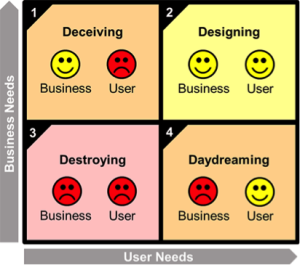User Experience isn’t just for UX Designers
We’ve firmly left the era where UX can be underwritten as a meetup buzzword or a mumbo jumbo design specialism. UX – or great user experience – should be a guiding force of product managers no matter what the industry. In fact, the role of the product manager is arguably to be the master thinker and architect of the big picture user experience. Most important to remember is that UX is not the finishing touch for product choices, but a mode of thinking that informs user-focused decisions and business longevity every day.
3 UX principles for better product development
1. Start by eliminating the negative experiences
No matter what your starting data source – from usability testing to customer support feedback – identifying and removing your customers’ stumbling blocks is the first step towards offering them a better user experience. Removing friction to a seamless experience is an essential prerequisite before you can really start to create additional value. Product people have much to learn from the classic psychology principle of negative enforcement: removing adverse stimuli can reinforce behavior for your users to return again and again. And those adverse stimuli should be sought out at every step of the customer journey. Removing friction goes further than high-level problem-solving, and deeply understands user behavior to make sure that a good idea to solve a problem isn’t thwarted by sloppy execution.
[bctt tweet= “Removing friction is an essential prerequisite before you can start to create additional value.”]
2. Stay focused on long-term user goals
To remain experience-focused, product managers must continually seek to balance user and business needs. We could easily argue that this question of balance is misleading as ultimately, these are one and the same thing. Continually meeting their needs puts you in the strongest position to retain your users’ custom. But every product manager knows that day-to-day decisions aren’t immediately that simple. When faced with short-term commercial concerns, technical objectives and even pure asthetics, it’s easy to lose sight of your raison d’être – long-term business success. Paul Brooks has neatly adapted the Steve Covey time management quadrant for this balance, where intelligent design is the sweet spot for meeting long-term goals.

3. Be one step ahead with proactive experiences
Living and breathing your users’ needs means that you can delight customers with proactive user experience design. Going a step further than removing friction, you can actually anticipate where your customers will encounter problems before they come to you with them. Ensure that the products you build guide your users rather than provide them with information to figure it out themselves. And to really meet their long-term goals, dedicate time to imagine features that go beyond the expected. A completely comprehensive approach to user experience considers every possible angle and aims to never leave customers waiting for more.
[Tweet “User Experience isn’t just for UX Designers”]
Limited time bonus! Join us for the Lean UX workshop on Thursday, September 11th in London. Claim your 15% discount here (good for two workshops).
Sign up to our monthly newsletter, The Outcome.
You’ll get all our exclusive tips, tricks and handy resources sent straight to your inbox.